Internal doors help us escape for 5 minutes of peace in a busy house, lock warmth in on cold winter nights and generally help our homes feel more homely. But picking the right internal doors can be difficult. Are glazed doors better? Which kind of wood is best? What is the best style for longevity?
Stress no more. We’ve compiled a guide to internal doors. In this blog, we’ll discuss everything you need to know to make the best decision for you and your home.
What are internal doors and why are they important?
Internal doors refers to any doors found within a property. These can be doors that split rooms off as well as doors to storage areas and other sections of the home.
Internal doors are important for a number of reasons from privacy and peace to energy efficiency, comfort and even fire safety.
What to consider when choosing doors?
When choosing internal doors for a property it’s important to consider a range of factors such as style, functionality, and of course your budget. Modern internal doors are manufactured using various materials and finishes that can sometimes impact their suitability in certain properties or settings. Understanding how style, material and size can affect a door’s suitability will help you make the right choice for your home.
Let’s break those down further.
Head: This is the horizontal part of the door frame which sits directly above the door. If fitted and working correctly the door should fit snuggly in place against the door jamb when closed.
Door Jambs: these are the vertical elements of the door frame that sit on either side of the door (hinge side and latch side). Again the door should fit flush within these elements when closed.
Now, let’s move onto the door itself.
Top Rail: This is the part of the door at the very top (outside of any panelling or glazing) and acts as a border or casing for the panels.
Mid Rail: Also known as a lock rail, this serves the same purpose as the top rail and runs horizontally through the centre of the door, in line with a hinge or latch.
Bottom Rail: This is a section at the bottom of the door that acts in the same way as the top and lock rails.
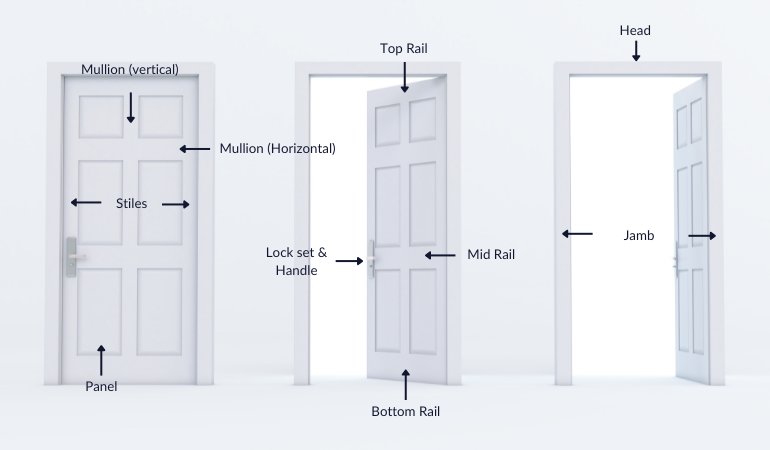
Stile: Stiles are the sides of the door that act similarly to the rails mentioned above. Combined with the rails the stiles make up the structure of the door itself.
Mullion: Mullions are the sections of the door that help divide and support panelled designs. These can be placed on the door horizontally or vertically, or both.
Panel: Panels are the sections that make up the primary surface of the door. Depending on the style of the door there may be just one solid panel or several panels.
Glazing: Similar to a wooden panel, this refers to the glass panel(s) in a door.
Hinges: The hinge is the plate the door swings on. A hinge has two sides which join in the middle with one side fixed to the door frame and the other fixed to the inside of the door.
Different types of door
When shopping for internal doors the options can seem endless, with huge choices of styles and types available. Don’t let the options overwhelm you, instead arm yourself with knowledge. Understanding the different types of doors, their benefits and their disadvantages will help you narrow your search, filtering products based on your preferences.
Pre-finished doors
Pre-finished doors are doors that have been completely finished by the manufacturer and are ready for installation upon purchase. There is no need to sand, prime, finish or treat these doors as this is all done by the manufacturer. However, this doesn’t stop you from refreshing your doors in the future with paints, stains and other treatments.
Unfinished doors
Unfinished doors are doors that are partially finished by the manufacturers. These doors can come both pre-sanded and ready for treatment and without sanding. Depending on the style, some are not primed, painted, or stained in any way. However, it’s worth remembering that with white doors, a lot of these come pre-primed. These give you a little more flexibility when it comes to colour and finish. However, it’s important to remember that these doors will need to be finished by you or a professional before installation to ensure longevity.
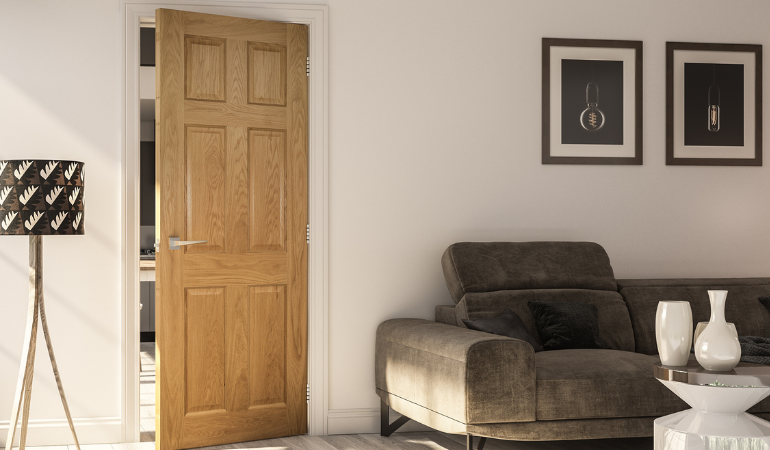
Pre-glazed doors
Pre-glazed doors are doors which are finished with glazing, specific to the design of the door. It’s worth noting that, glazing cannot be changed by the manufacturer once installed.
Ready to glaze doors
These doors are designed to feature glazing but are not finished with specific glass. Instead, you are given the option to choose your glass which gives you more flexibility to tailor these doors to your unique style.
Flush doors
Flush doors are doors made up primarily of engineered materials such as MDF or chipboard. A wood veneer is then placed over this material, giving the aesthetic effect of these woods for example Oak or Pine.
Solid core doors
Solid core molded doors feature a veneer of quality wood coating a centre made of lesser quality wood that has been chipped into durable fibreboard. Aesthetically they perform like the chosen wood veneer, however, the inside materials make them more budget-friendly.
Hollow core doors
Constructed similarly to solid core doors, hollow core moulded doors have an entirely hollow centre or a centre made of cardboard materials or thin plastic. Again, these mimic the aesthetics of the chosen veneer but do not possess the same heat or sound insulation, durability or strength.
Solid wood doors
Solid wood doors are exclusively made of a single chosen wood and can be costly compared to other alternatives. These doors react to temperature causing shrinkage and expansion, making them difficult to use in bathrooms and kitchens.
Which material is best for internal doors?
Picking the best internal doors will vary from property to property, depending on personal preference, usage, and other variable factors. However, we think it’s important to know the pros and cons of each material so you can make the right choice for your home and invest in doors that won’t let you down.
Internal Oak Doors
Oak is one of the best materials used for internal doors, thanks to its heat and sound insulation. As a hardwood, Oak possesses excellent longevity too making it a strong choice for busy households, those with pets or young children. However, Oak internal doors can come with a bigger price tag than alternatives so consider this too. Depending on the type of door, Oak can also need more maintenance than other alternatives, but when used internally this is less of an issue.
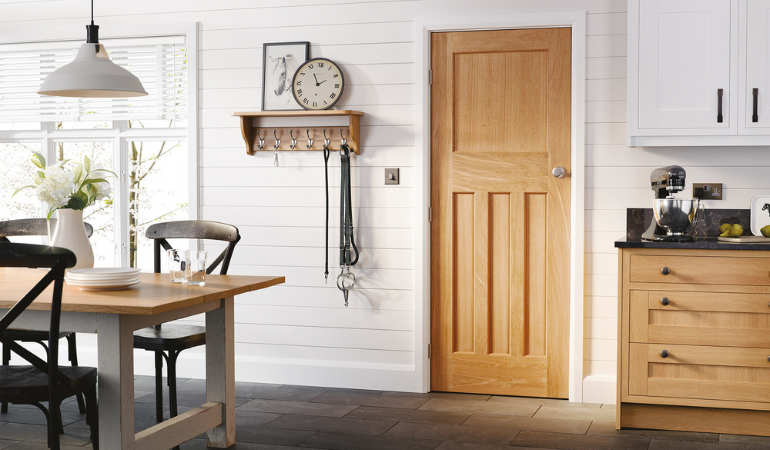
Internal Pine Doors
Pine doors are a more cost-effective alternative and still make a great choice for internal doors. They are lightweight and surprisingly resistant to shrinking and swelling brought on by changes in temperature. However, as a softwood, Pine is more likely to scratch and dent meaning these wouldn’t be ideal for people with pets or young children.
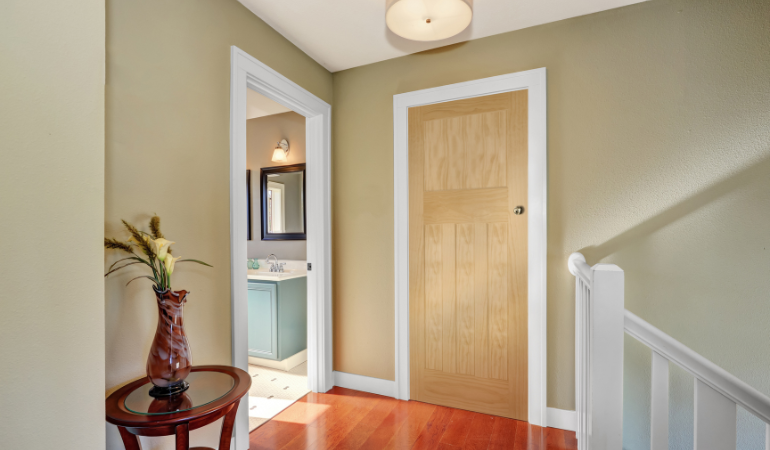
Internal Beech Doors
Beech doors have fast become a popular option for internal doors. As one of the least expensive hardwood options available beech doors definitely hold their value. Offering hard-wearing longevity and a stylish finish Beech doors are a safe choice for all types of properties. However, Beechwood absorbs moisture very quickly which can cause damage to the wood, such as warping. So, consider this fact before using it for bathrooms or internal access to garages or other external spaces.
Internal Walnut Doors
Walnut possess all the qualities of a brilliant internal door such as strength, stability and durability. Its incredible resistance to wear and tear makes it the perfect choice for busy homes. Visually darker tones and its ornate patina make Walnut a popular choice amongst those wanting to make an impact in their home, suiting contemporary and classic in equal measure. However, Walnut doors can be slightly costly compared to other wood alternatives.
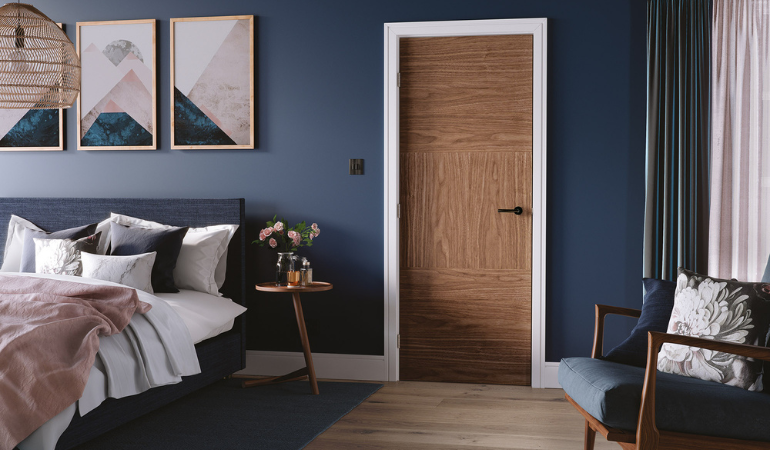
Internal Plywood Doors
Plywood doors are some of the most robust and durable internal doors available. Their simple, light appearance often undersells their performance amongst the likes of oak or walnut doors. However, Plywood doors offer years of durability, meaning less costly replacements over the years. Maintenance needs are also limited for plywood doors, making them versatile for use in all spaces. However, the unique appearance of plywood doesn’t always complement interiors, and most people opt to paint these to match their interiors.
Internal Paint Grade Doors
Internal paint-grade doors are a brilliant choice thanks to their versatility and ease. Composed of ‘paint-grade’ woods these doors ensure a completely flat surface which is free from any noticeable wood grain, knots or uneven textures. As the name implies, paint-grade doors are specially developed for those wanting to paint their doors and achieve a unique look that complements their interior. Durable and cost-effective these doors allow you to achieve the exact look you want, without breaking the bank.
Choosing the right door size
When replacing or installing new internal doors it's crucial to note the size of the doorway you will be using. Understanding your internal door sizes and any restrictions to your entryways will help you filter out inappropriate solutions and find a suitable door.
In the UK the most common standard door size is 1981 x 762 x 35mm. Manufacturers or vendors may also refer to this door as 2’6” in their descriptions or listings. However, at Doordeals we offer custom dimensions on a huge selection of our doors, making it possible to secure the style you want in the right size. Browse our custom-size doors to see if we can help you.
If you’re unsure of the size of your doorway, visit our door measuring guide for a visual guide on measuring doors for the perfect fit.
What type of internal doors are best?
Now we’ve explained the different types of internal doors, let’s discuss internal door styles. With so many styles available it can be difficult to envision how a door might look in your space. In this section we’ll give you some examples of each style, helping you understand where these will work best.
Solid Core doors
Solid doors are a versatile choice. They come in a range of designs with panelled and flush options available in a variety of shades, colours and tones. They are great for privacy and comfort and are suitable for use throughout the house, particularly in bathrooms and bedrooms.
Browse our solid internal doors to find our entire collection.
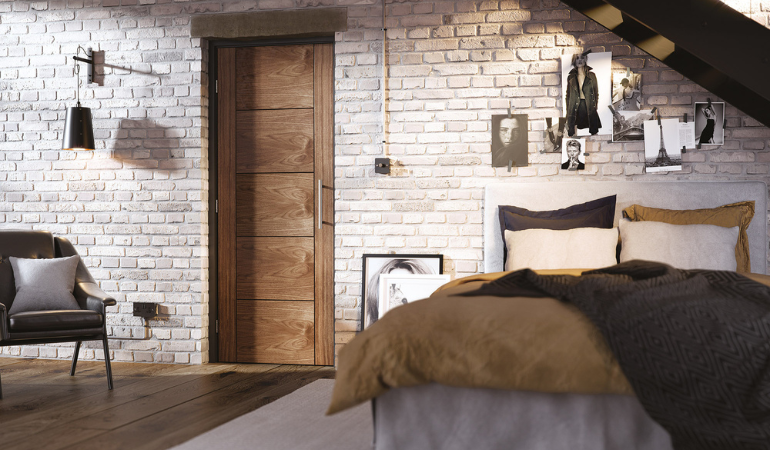
Glazed doors
Glazed doors are available in as many combinations as solid doors but their glass components make them slightly less versatile for use in bathrooms, or other private areas. However, they’re great at letting natural light into living spaces and emphasising the effect of this light.
Discover our full collection and shop our internal glazed doors to find more.
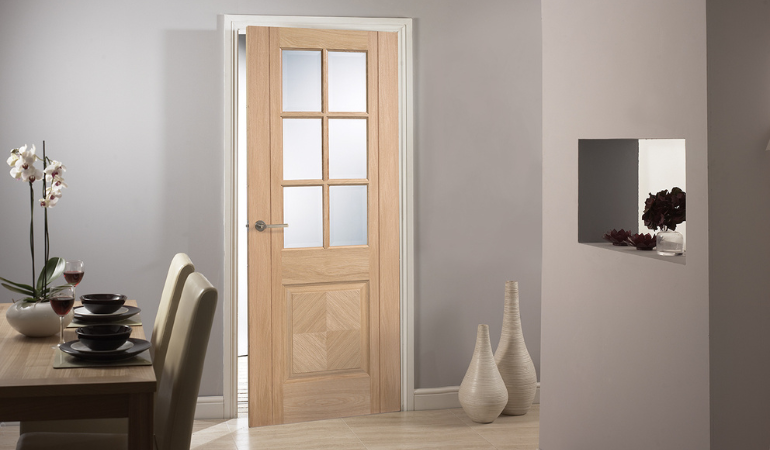
Panelled doors
Panelled doors can be both traditional and contemporary, depending on your chosen style. The most traditional style is a 1930’s panelled door, such as our Oak DX 30’s 6-panel door. This is a timeless design staple that’s perfect for more traditional homes.
Alternatively, our Oak Coventry offers a more contemporary take on a panelled door, available in oak or white finishes this is the perfect addition for modern or traditional homes alike.
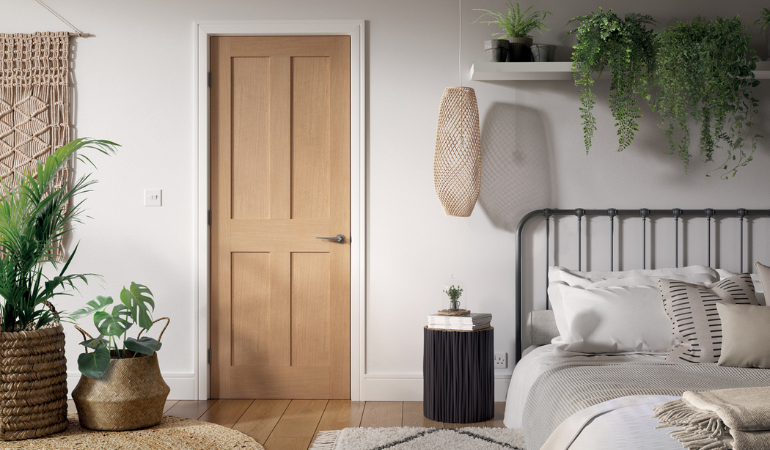
Barn doors
Barn doors are the perfect rustic choice for farmhouses and cottages or simply for homeowners wanting to tap into the property’s original features. Their rustic style makes them perfect alongside exposed beams and homely wooden accents.
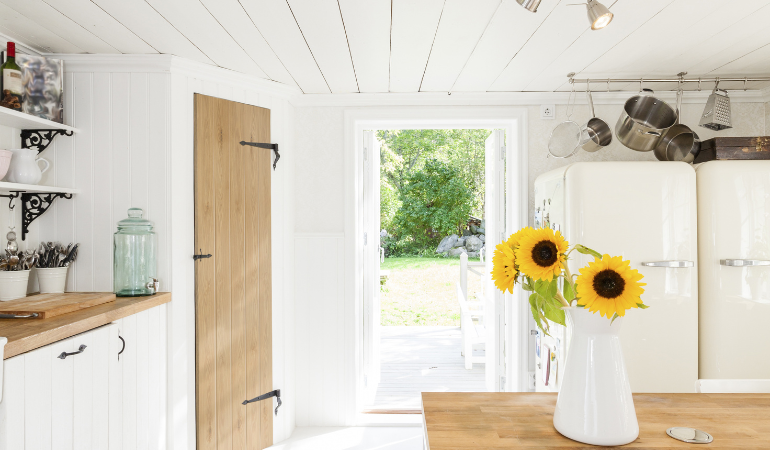
Internal bi-fold doors
Internal bifold doors are great for maximising space in multipurpose spaces. Their versatility allows you to part your space into two distinct spaces as well as open this space up for a multi-use space when entertaining. Available in glazed and unglazed styles these doors are great in more modern homes.
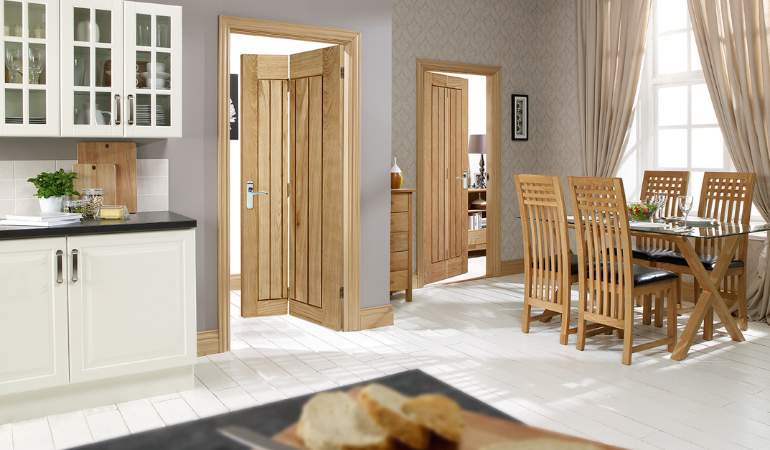
Internal French doors
Internal french doors are a great choice for those looking to enhance their space. A more traditional alternative to bifold doors, French doors allow you to achieve the same space-saving and transformative results. Available with and without glazing, French doors are best suited to more traditional and elegant properties, enhancing this aesthetic with added functionality.
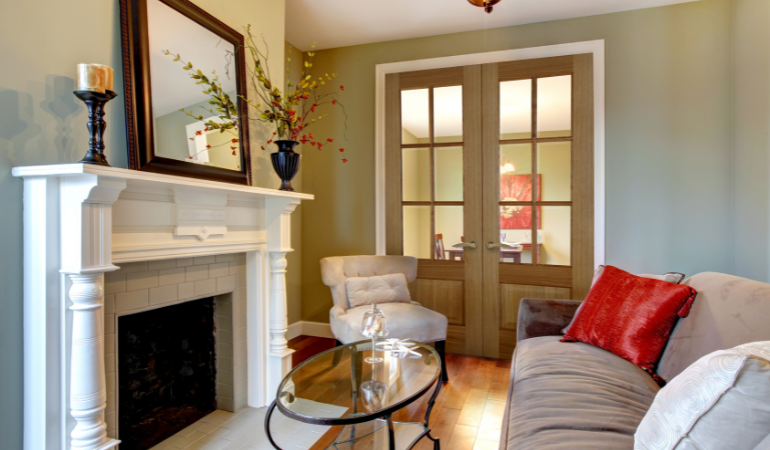
Discover even more inspirational styles and browse our complete collection of internal doors.
Conclusion
When picking internal doors, remember to lead with your needs. Figure out which features you want, what style you’re creating in your home and how much you’re looking to spend. Then, armed with the knowledge from our guide, you can find the perfect door for you, your budget and your home.
For further information on how doors are manufactured and the benefits of each type read our door construction article.
We hope we’ve answered your questions and helped guide you to your perfect door. But, if you’ve got any more questions or want further advice please get in touch. Our team of experts are available via live chat or email to help answer your questions.
